#llayan wildlife
Text
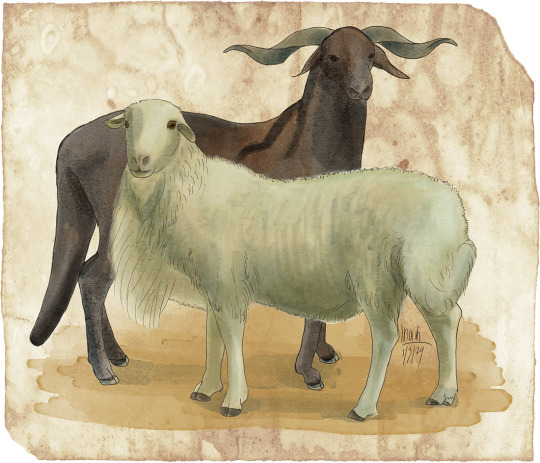
Llayad has sheep, which are basically the Afrikaner sheep (dark one) native to South Africa and the damara sheep (white one) native to Namibia. Both geared for living in the desert, they have fat tails which function like a camel's hump, and they're a particular delicacy to Llayans. Their hide makes for particularly soft leather and is used as gloves and soft shoes. The rams of both breeds have curly horns, which continue to grow through the animal's life. After their death, the horn is used for anything from buttons to serving spoons.
The wooly one is farmed in the mountains, where their wool is used as both the fibre and as the floofy hide for lining boots and such. They have short hair in summer, not as short as the plains breed but enough to keep them cook, then it thickens out to dense wool in winter before being shed in spring. They get brushed every day as they're moulting and their wool collected to be washed and spun as fibre or matted into felt. The hairs are thinner and softer than real-world sheep just cos I find wool can be kind of itchy :< also in a world where they have marsupial fur as a standard soft textile, sheep have something to live up to.
The sleek one is farmed on the plains and is just farmed for meat and hide.
7 notes
·
View notes
Text
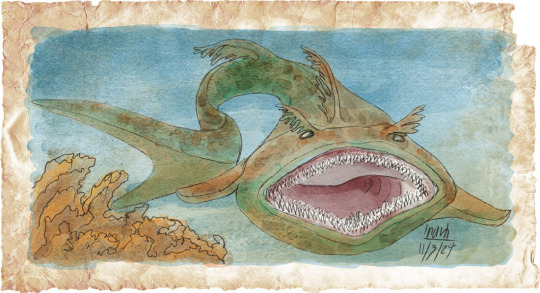
The zahnenzaun, or fence of teeth, is a semi-mythical creature living in the Llayan Great Lake. It's seen rarely enough that nobody knows what it looks like, just general impressions of brown fins and the holy shit teeth fencing off that gaping maw. It has been known to attack people, lending credence to its existence, but it still has almost Loch Ness Monster standing among those who don't live on the Great Lake.
In reality, the zahnenzaun is a freshwater shark, a bit smaller than a great white and a bit of a cross between a wobbegong and an eel, not much more than a mouth with a tail. It lives on the lake bottom where it feeds on other bottom feeders, out where the water is quite deep. It's mostly an ambush predator, hiding amongst the seaweed before launching itself in that way sea creatures do and taking down its prey. Very occasionally, when it hasn't eaten in a while and it's REALLY hungry, it'll pursue its prey up to the surface and breach the surface with a great gnashing of teeth before disappearing back to the depths. If it sees a fisher's legs standing there in the shallows, then so much easier for the zahnenzaun. As with saltwater sharks, though, they don't like the taste of humans so they'll invariably spit them out and swim away.
#zahnenzaun#fence of teeth#freshwater shark#lake monster#llayad#wildlife#llayan wildlife#artists of tumblr
3 notes
·
View notes
Text
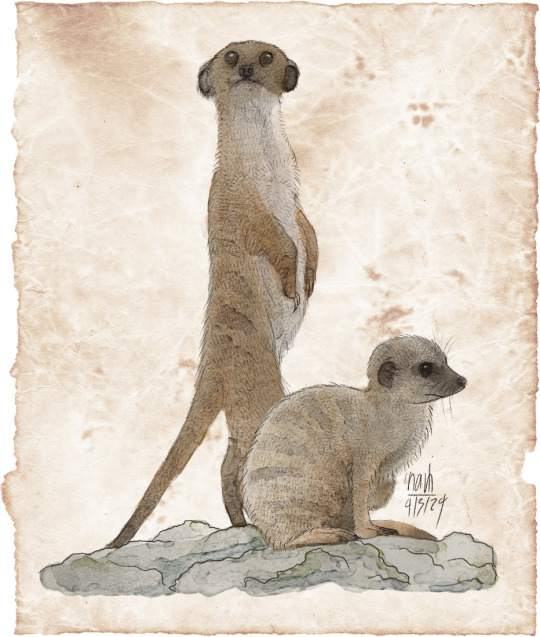
MEERKAT.
I have nothing else to add.
3 notes
·
View notes
Text

There's really nothing to say about this one, it's a butterfly :D In my favourite colour combination of citrus colours :D I hadn't yet made an insect for Llayad, was thinking of Christmas beetles, or a fuzzy wuzzy something, or a butterfly cos I hadn't done one yet, then discovered that fluffy beetles are in fact a thing and they're so cute I won't top them, so butterfly it is.
This one's the male, with the female being slightly larger but duller and with a second of the small tails instead of the full ribbons.
2 notes
·
View notes
Text
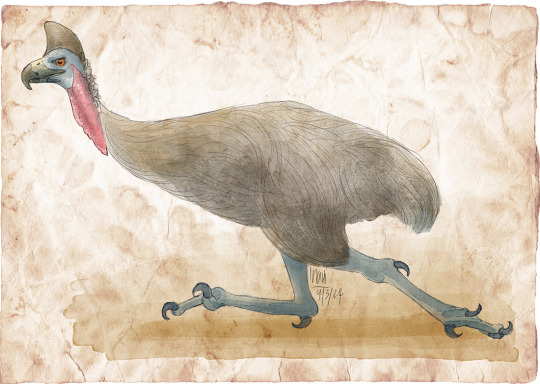
MORDVOGEL.
I've now drawn all the creatures I've already stuck into Llayad, so now I'm up to the kind of fleshing them out part, creating more critters to throw into the narative when I need. One of those is another bird, because I've only got the flamingo and hummingbird so far. So I was thinking of a bird of prey, except I've already got the griffin filling that role, and why am I going to stick an eagle in the sky when I can soar a griffin through there? So next I was thinking maybe a flightless bird. Some sort of ostrich, moa, emu, cassowary type thing… and because I already had birds of prey on the mind… cassowaries are already evil murder birds… why not make it a proper, truly legit murder bird and make a flightless bird of prey? I google translated murder bird into German, because Llayad is the Barossa but make it Africa, and it spat out mordvogel and I was sold.
The mordvogel is, obviously, a terrifying creature. It has an eagle's beak, a velociraptor's hooked toe because why the shit not, all fused onto an emu's body that can run at 60kph and is one of the fastest creatures in Tsyllaes. They're territorial birds, solitary until the breeding season, when they pair up and raise their chicks as a pair. Both parents equally share the roles of sitting on the eggs/chicks and hunting as well as teaching the chicks to hunt. Once the chicks are grown enough to go out on their own, the parents separate with the female keeping the same territory while the male goes to find a new mate.
They hunt by sitting down in the grass of the savanna and scanning through the grass for a likely victim. They'll then launch off the ground and sprint after their quarry. When they catch up, they jump up on the prey's back and dig in with those massive claws and beak, ultimately aiming to claw the throat open and tear it to shreds like an eagle. Both extremely agile and with huge stamina reserves, the mordvogel can run at top speed for way longer than any of its potential prey animals. If it gets its sights set on you, you are stuffed. Just show it your neck and hope it gets it over with quickly.
2 notes
·
View notes
Text

Wildebeest are the cattle of Llayad, living in farmed herds as well as the 100,000+ wild herds. The farmed herds of a few hundred to a few thousand migrate with the wild herds, and the drovers work to protect their herd from predators until they reach their northern farms. Groups of nomadic hunters will often also work to protect wild herds on which they live.
2 notes
·
View notes
Text

This feels like the Most Fantasy I've drawn, and I've done dragons and griffins. This is a battle turtle, which lives in the Llayan Great Lake. The name comes from back in the day when Llayad was a more warring nation and they'd use their shells as shields. Whole lot of leafy seadragon-esque fins floating around them for camouflage, and freshwater mosses grow on their shells so they can really blend in with the rocks on the lake floor. They have a long helmet so when they draw their head in they have an extra spike sticking out, more spikes on their shells, a long hooked beak and frigging sawblades of scales on their front fins, but they're not carnivorous. This is aaaaall defensive, because something else lives in the Great Lake, oooooooOOOOOOOOooooooooooo.
They're also, predictably, a delicacy in Llayad, but it's a criminal offence to raid their egg nests.
1 note
·
View note
Text

SNEK. This is the fire spitter cobra of Llayad. It does not spit fire (otherwise it'd be the firespitter or fire-spitter cobra), just has a fire pattern on its hood and it spits venom. In looking for refs, I learned four of the… ten, I think? species of cobra in Africa spit venom. It's just as a defence mechanism so it's not going to kill you, just temporarily blind you so it can flee. Even on humans, you just rinse it out with water and after two days, you're fine. Like it sucks, but compared with the alternative of being bitten by the snake, being spat in the face is definitely the better alternative.
I went through so many options for the hood pattern. Started with maybe a shield, looking up patterns first of African shields, thinking maybe that might be a bit too appropriation in my kingdom of whitey mcwhitefaces, so instead looking at ancient Germanic shields, but none of them worked as a snek hood. Thought of mirroring a constellation maybe, but decided there was already enough going on with Llayan fortune telling and reincarnation that I didn't need to bring actual astrology into it, too (snake is one of their zodiac creatures). Finally settled on the flame pattern, I think because I was looking at the spitting ones and had the phrase 'fire spitter' come into my head.
0 notes
Text
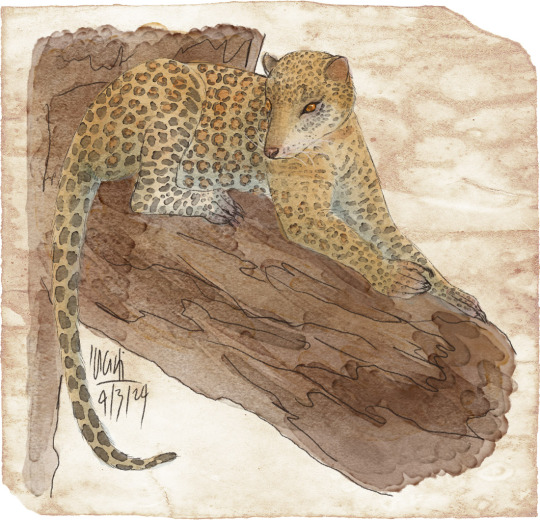
Like the marsupial lions of Raykin, Llayan felines are largely marsupials, which includes the leopards, so I gave them more marsupial-looking faces and paws, based on a quoll. Their general lifestyle is otherwise like a leopard--solitary big cats that hunt and drag their prey up into trees then leave them there for a while before they come back and eat them.
0 notes
Text

Idk it's a bat with a long tail. I have a bunch of creatures that have only come up in name. So bats exist in Llayad. I gave it a long tail so it can hang from trees by its tail! Idk maybe it's fully prehensile like a monkey, cos that sounds like fun.
Oh and, like Raykinians, Llayad believes bats lay eggs, cos they fly like birds and monotremes are a thing and griffins lay eggs so in their world, it makes sense. They're just bats, tho.
0 notes
Text
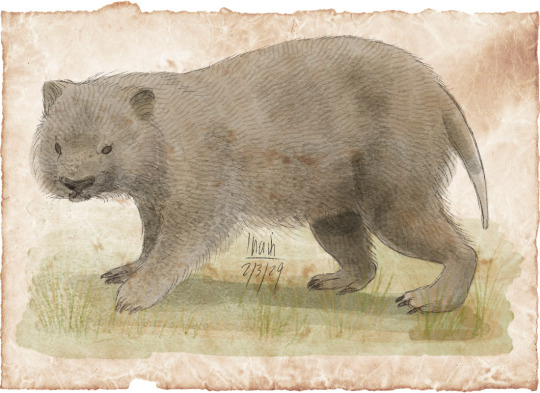
So I read this article after I'd finished the Kazinian giant wombats, figures. So this one is from Llayad! Mukupirna lives in the Llayan mountains where it doesn't burrow, cos the ground is too rocky or boggy. It lives on seges, roots and tubers.
0 notes
Text

I like griffins with the front legs being the eagle's legs, otherwise to me it just feels like a cat with wings and an eagle's head. Also, because these are real creatures in Llayad and not beings of myth, they aren't gonna be the size of lions because I can't envisage something that big being able to fly. So they're not big cat sized. Also more exist than just these four, these are just the ones to fill all the biomes so I've got something. If I need more later then I can make more.
Llayan griffins are, as I say, like any other wild animal. They live as mated pairs for life and have a clutch of three eggs every five years. As the chicks learn to hunt and become more independant, the parents take less and less part in their lives and they leave to find their own territories.
The legend goes that a griffin's feather restores sight to the blind, but only when given as a gift. I wrote a story about that about a decade ago. Idk whether the legend is true or not, but I don't think so.
The griffin is also one of the zodiac creatures, the sign for those born in the first half of autumn. I'll get into that when I draw the pics for the zodiac =3

The tawny sand griffin, the only truly desert-dwelling griffin. It's only small, smaller than your average house cat, with a stumpy little tail and floofy paws so its feet don't get burnt on the sand. Named the tawny sand griffin cos I used a tawny eagle and a sand cat as reference, both natives of the African desert. Sand cats are tiny adorable babies.
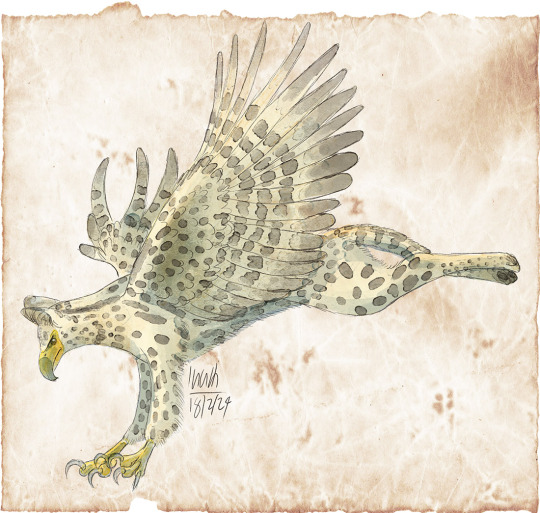
The original griffin I created based on a serval! This one's the native of the savanna. Loooong elegant legs, much pretty kitty :D
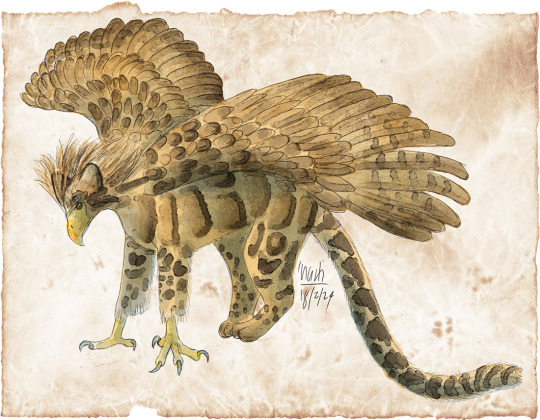
Clouded griffin of the Llayan forests and lowlands, based off a clouded leopard because I LOVE those things. They're from the rainforests of South-East Asia, so not quite Africa but still fits in my world. I therefore also googled eagles of SEAsia and found the Phillipine eagle, which has an impressive mane, so this is the only griffin with a mane.
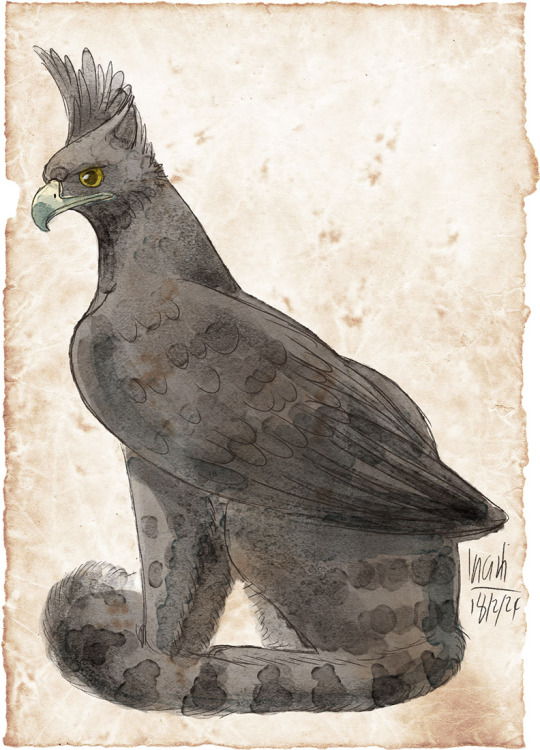
The biggest griffin, from the Llayan mountains. These aren't based on anything in particular, though I used a crested eagle as ref for the eagle part, the mottled grey/black patterning just fits the mountains.
#griffin#llayad#wildlife#llayan wildlife#tawny sand griffin#serval griffin#clouded griffin#mountain griffin#artists of tumblr
0 notes
Text
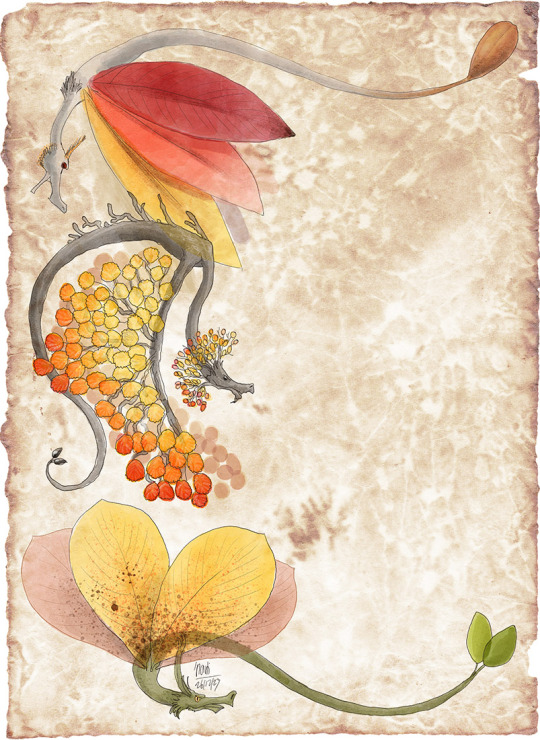
LEAF DRAGONS! I've been really looking forward to drawing these little guys <3 They can grow to be huge, with the oldest, Oak, the size of a small forest, but these ones are just little, the thickness of your index finger. Llayan dragons all share their appearance with the trees around them.
I always associate Llayad with golden colours, therefore autumn, but deciduous trees from Australia are thin on the ground (there are two, one of which is subtropical) and I've not found one at all in South Africa. The single temperate deciduous tree I've got is the tanglefoot fagus, represented by the middle dragon here. Llayans therefore refer to autumn as the 'turning of the fagus.' There are three other related faguses (fagi? idk), all of which are evergreen and one of which is actually Kiwi, but screw you I'm bringing them into Llayad and making them deciduous: the myrtle fagus, flat-leafed fagus and the silver fagus.
Red moulmein cedar, represented by the top dragon, is the one that's technically subtropical but I'm stretching it into the Llayan mountains so it can also be temperate. Ditto the white lilac, which is more of a tropical tree that goes gold when it feels like it (so far as I can tell). There's one next to the cafe I often have lunch at and I had no idea it was Australian. Definitely not native to my area but there you go, Llayad can have them.
Finally the, almond of flame, represented by the bottom dragon, is again a straight up tropical tree I'm making temperate, native to south-east Asia so y'know what it counts. That's as native 'deciduous' as I've managed to get.
This is all relevant to the dragons, because the deciduous ones will turn to autumn colours and subsequently lose their leaves in winter, so they can no longer fly until they get new bright green growth in spring. They have seedpods which grow at the tip of their tails, which they'll then drop in the ground and let it grow into a tiny new sapling of a new dragon!
Dragons are very much creatures of magic, nothing to do with fire (though, idk, maybe those which do well with fire and need it to germinate seeds do make fire) but they have some connection with the wind and the weather. I know exactly what that connection is but that's spoilers, so shh. They communicate with twists of wind around the ankles, an uncomfortable breeze up the back of the neck or a soft waft through the hair, up to destructive gales and dark clouds full of lightning.
They may or may not be related to the sea dragons of Tsayth, who can tell?
#dragon#leaf dragon#llayan dragon#llayad#wildlife#tanglefoot fagus#fagus#red cedar#red moulmein cedar#almond of flame#artists of tumblr
2 notes
·
View notes
Text
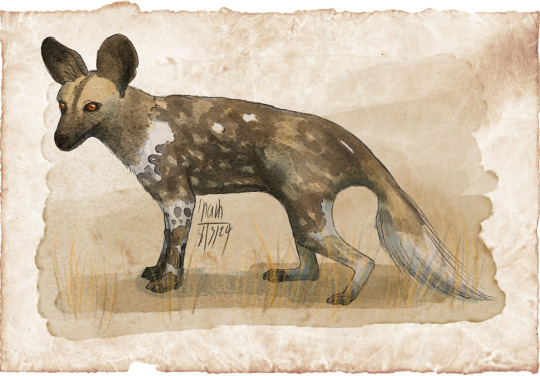
Canines don't technically exist in this world, because I~ am not a dog person. The Llayan wolf is a Tasmanian tiger with the big ears, floofy tail and gorgeous markings of an African wild dog. It's still a marsupial, so has the pouch and the weird back legs and HUGE jaw of a Tassie tiger, and not technically a dog. Aside from the appearance and the pouch, though, the Llayan wolf functions like African wild dogs, living in big packs with strong social bonds.
They have been domesticated, but they still need to keep their big packs so it's really only in castles with room to keep enough to keep them happy. They're kept as hunting dogs rather than as pets.
#llayan wolf#wolf#llayad#african wild dog#african painted dog#african painted wolf#marsupial wolf#tasmanian tiger#wildlife#artists of tumblr
1 note
·
View note
Text
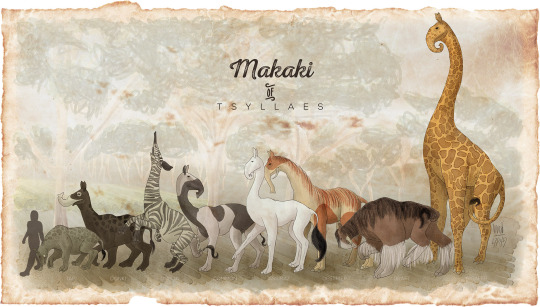
This is almost entirely unchanged from the original, I've just gone over them all with watercolour to fit the rest of my wildlife fact file pics. I will therefore copy-pasta all the text from last time.
Makakis came about because screw horses. Horses are way too finicky. Horsey people are very knowledgeable about horses; I couldn't give a shit about horses. I give up trying to make my horses realistic.
Also, on a side note after seeing a bandicoot digging at Mum's lawn yesterday, I had the idea that most mammals in Tsyllaes should really be marsupials, what with it being based pretty heavily on Australia and all.
I decided to try combining these ideas, starting with real marsupials, the extinct megafauna. Honestly the only one big enough to ride is the giant wombat, which absolutely bloody exist in Tsyllaes now, but not overly convenient as a steed. I looked then at extinct mammals to see if anything else might be useful, and came across the macrauchenia, some weird South American creature which was its own evolutionary branch, unrelated to anything else that currently exists. The closest they've got is the tapir/horse/elephant branch. PERFECT. Also I can find virtually no info about this thing.
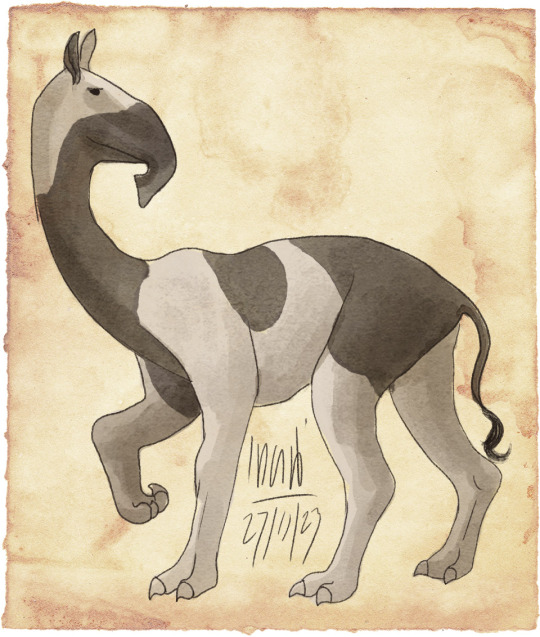
The common makaki is the one people think of whenever they think of a makaki. In keeping with their not-horse origins, their patterning is generally anything that a horse can be, as well as in keeping with their being marsupials, anything marsupials can be. They're about 2m tall at the shoulder, so significantly bigger than horses, but they're also very chill with sitting, most often lounging like kangaroos. I wanted to draw one lounging here but I needed to show the heights, so I'll do that when I eventually draw the Own's makakis. They have three toes on each foot, which makes them more agile and gives them stronger ankles than horses so the sodding things don't break their ankles.
They live mostly in the mountains and hills of Kazin, Llayad and northern Raykin, where they use their snoots to pull leaves off of trees for food, occasionally fruit if they can get it but they're fine off leaves. They're suited to Kazin's open forests and the plains of Llayad, not so good in full desert with their comparatively small feet and need for water. Those from tropical forests and the Llayan savanna have no mane while those from the colder mountains have manes all the way down their back. The particularly cold border between Llayad and Kazin also breeds them with floofier coats.
Llayans call these ones Kazinian makakis, because Llayad has their own 'common' one.
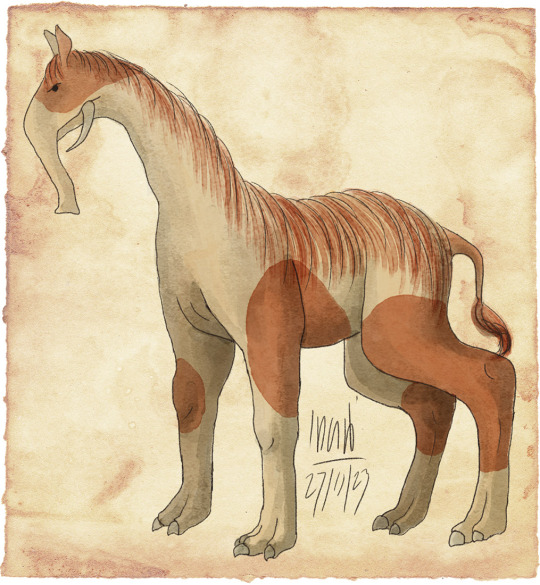
The destrier is the one bred for battle. Bigger than the common makaki and with very strong legs, especially the back legs for springing forward from a stationary start. They have the longest tusks of all makaki breeds which can be an extra weapon in battle, and longer trunks, too, cos. I dunno. I felt like playing with the trunks. I'm sure there's an application for that.
Also, side-note, this one's Mongrel! After drawing all the boys' makakis, I've better figured out how their anatomy goes, so I've tweaked this one a fair bit from the original, giving him longer, thicker legs and changing how the back legs kink to be more like how I've been drawing them, a bit more strength and spring to them.
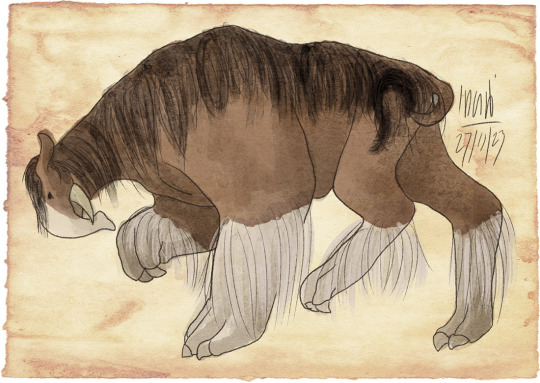
Oooooh he's a big, beefy boy, this one. The draft makaki has been bred for pure strength, huge forequarters for pulling heavy carts and plows, big feets for digging, strong trunk and tusks for pushing over trees and hauling branches.
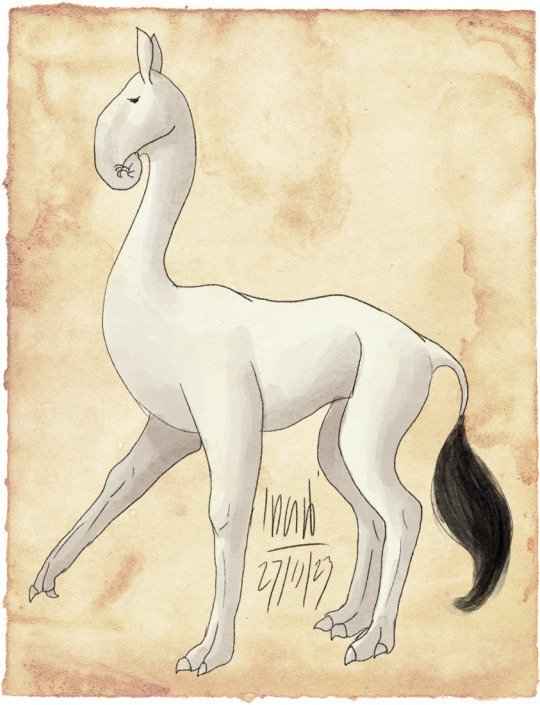
By complete contrast, Assiraz's makaki is bred purely for looks. The more snowy white, the pricier the animal, except their swishy gorgeous tail which has all the colours. Long, elegant legs and slender, curving neck. They're named after Empress Assiraz, who was the one to start breeding them in the first place. Literally their only use is to keep nobility's skirts clean and elevate them above the plebs, so in that regard they're highly practical. For anything much else, they're kinda useless.
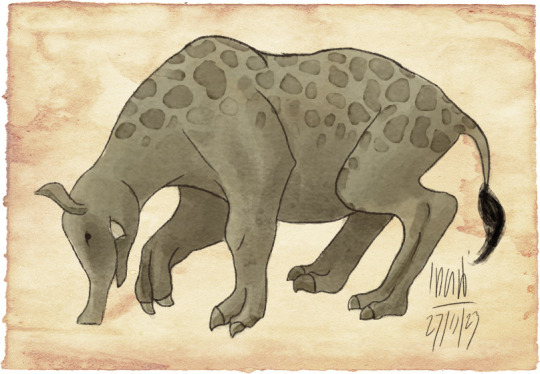
Native to the tropics and bred for its meat, the stocky little tapi has patterning on its back like a giraffe and range from grey, like the above, to dark brown with black spots to better camouflage. They taste like camel. I've never eaten camel so just roll with it.

DONKEY. Or more technically a mule, but I just wanted to call it a donki. It's a hybrid between a tapi mare and common stallion to make a smaller makaki, less fragile in the legs giving them greater endurance than the common makakis, but because they're much smaller they're cheaper for the average Kazinian. More than half the donkis are sterile, which makes those ones nice and cheap for the poorer Kazinians, and even those which can breed are still significantly cheaper than common makakis and WAY cheaper than draft makakis.


The two Llayan makakis, first one just called the 'Llayan makaki,' but, as mentioned before, Llayans call this one the 'common makaki' and the other one the 'Kazinian makaki'. She reach! And she has a foal in her pouch :D Llayan makakis are a bit smaller than the Kazinian ones. Also, because they're not actually zebras, the dark stripes can be any colour, though herds are mostly all of one colour.
Secondly, the rigaffe! Tollu girl is tollu, though I did shrink her a bit from the original. I think they also have colour variations, too, but always with the giraffe-like patterning. If you're wondering how the joey gets back in the pouch, it doesn't. Once the joey has left the pouch, that's it, it's out for good.
#makaki#assiraz's makaki#common makaki#destrier makaki#donki#draft makaki#tapi#llayan makaki#rigaffe#marsupial#kazin#llayad#artists of tumblr
1 note
·
View note